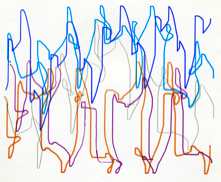contact me for any information or comments
Taitographs
Images made by programmable drawing machines
The process of making Taitographs differs from that of writing a computer programme. There a notion of the final outcome is usually required before it can be written. Neither is it similar to kinetic sculptures, which draw with pen or light, as they are either wholly random, not subject to programming or they are limited in the range of expressive effects.
To put Taitographs in context, they occupy the middle ground between digital computer programming and sculpture installations which make drawings by pen or light. The images are the most important part.
The machines are design tools in that some can be programmed to repeat a drawing with some degree of accuracy. The randomness, termed ‘quasi’ (because it is not a true mathematical random number) is the outcome of a virtually unpredictable sequence of instructions which might take a very long time to repeat. In practice it acts in a similar way to a random event.
The combination of this input with a more deterministic set of instructions is crucial to the success of the final outcome. The ratio of one to the other is largely governed by intuition and experience when the machines are being designed. Clearly the selection process which operates ‘post drawing’ is also critical. These decisions are likely to be influenced by the ‘fuzzy notions’ of intent which existed in the mind during the design and construction of the machine. They are developed and enhanced through feedback from the final evaluation.
The machines essentially explore simple mathematical ratios and linkage character with subsequent post-drawing work done in Adobe Photoshop. Some of the images might be ‘read’ as being equivalent to hard edge abstract paintings which raises philosophical questions about the nature of art and how it works. This latter assertion rests on the existence or otherwise of a consensus, unless the viewer is happy to accept the 'Duchamp' definition "It is art because I say it is".
Recent work, from 2019, has been on 'near chaos'. The machines have been programmed to approach a tipping point where the drawing is almost chaotic but just retain some coherence. The inherent unpredictability of a number of D.C. motors running under different load and speed conditions augments the achievemnt of random output.
CLICK ON THE DRAWINGS OR HEADINGS TO SEE EACH TYPE
Early drawings
Meccanograph
Computer
Linkogram
NSEW
Light
Turntable
Scribblogram
Sinewave
Hommage to Henry
Taitographs are drawings made by analogue machines following simple instructions with an element of quasi-randomness introduced. They are either drawn by pen onto paper or by light into a digital camera. From 2019 to present research has been into 'near chaos' effects, see new pages.
Near chaos
Graphic Folio
Light Folio












